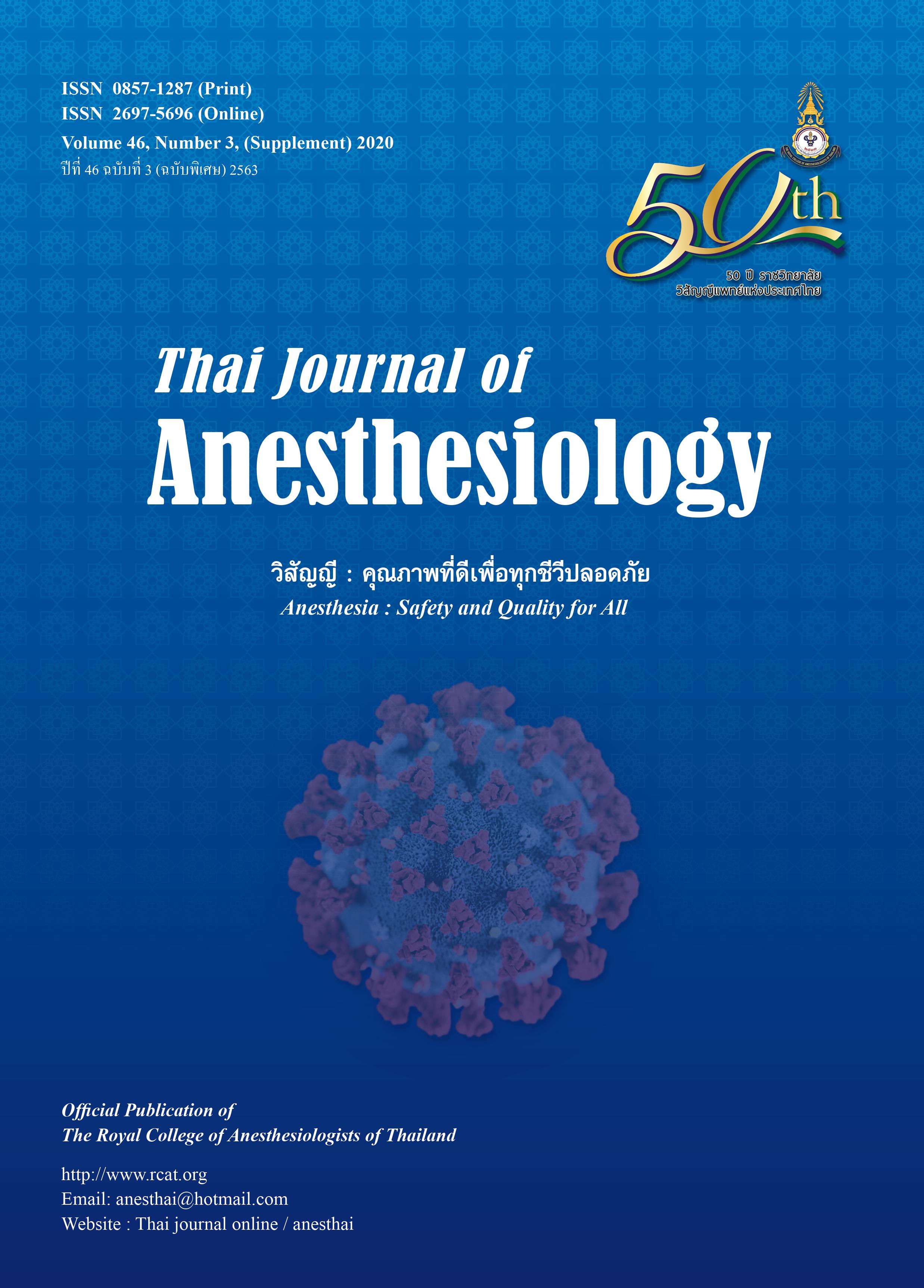Anesthesia Machine Use, Protection and Decontamination during the COVID-19 Pandemic
Main Article Content
Abstract
Anesthesia providers commonly cross-contaminate
their workspace and subsequently put patients at risk for
a health care-acquired infection. Controlling infection to
prevent the spread of SARS-CoV-2 is the primary public
healthcare intervention used. Anesthesiologists need to
participate in standardized infection control strategy to
contain COVID-19 viral transmission. Breathing system
filters will protect the anesthesia machine from internal
contamination and protect the environment when the
circuit is disconnected. The type of filter selected for an
anesthesia machine used is important for efficacy and
humidity concerns. Performance of filters designed to
protect against bacteria and viruses is measured using
the Bacterial or Viral Filtration Efficiency (BFE and VFE)
is reported for all commercial filters (>99.99%). APSF/ASA
recommend that a heat and moisture exchange filter
(HMEF) should be placed at the endotracheal tube
connection to the breathing circuit, and a second HMEF
or filter should be placed on the expiratory hose where it
connects to the anesthesia machine. Not only is the
second filter a reasonable backup to protect the machine
from any particles that pass the primary filter, but it
significantly amplifies the effectiveness of the first filter.
The complications associated with HMEF may increase
the resistance to gas flow, ventilation, dead space and
blockage with liquid. The airway mounted filter will need
to be changed between every patient, whereas the
expiratory limb filter seems like an option to leave in place
between patients 24-48 hours depend on the type of HMEF
or according with the manufacturer’s recommendations.
Article Details
References
2. Odor PM, Neun M, Bampoe S, et al. Anaesthesia and COVID-19: infection control. Br J Anaesth 2020 April 8. doi. org/10.1016/j.bja.2020.03.025.
3. Tran K, Cimon K, Severn M, Pessoa-Silva CL, Conly J. Aerosol generating procedures and risk of transmission of acute respiratory infections to healthcare workers: a systematic review. PloS one 2012;7:e35797.
4. ราชวิทยาลัยวิสัญญีแพทย์แห่งประเทศไทย. แนวทางปฏิบัติการดูแลผู้ป่วยติดเชื้อหรือสงสัยว่าติดเชื้อ COVID-19 ในการระงับความรู้สึก [Internet]. 2020 May [cited 2020 April 24]. Available from: http://www.anesthai.org/th/news/view/23.
5. Kramer A, Kranabetter R, Rathgeber J, Züchner K, Assadian O, Daeschlein G, et al. Infection prevention during anaesthesia ventilation by the use of breathing system filters (BSF): Joint recommendation by German Society of Hospital Hygiene (DGKH) and German Society for Anaesthesiology and Intensive Care (DGAI). GMS Krankenhaushygiene interdisziplinar. 2010;5(2).
6. Chant K, Kociuba K, Munro R, et al. Investigation of possible patient-to-patient transmission of hepatitis C in hospital. NSW Pub Health Bull 1994;5:47-51.
7. Walker SG, Smith TC, Sheplock G, Acquaviva MA, Horn N. Breathing circuits. In: Ehrenwerth J, Eisenkraft JB, Bery JM, editors. Anesthesia equipment: principles and applications. 2nd ed. Philadelphia: Elsevier Saunders; 2013. p. 95-124.
8. American Society of Anesthesiologists and Anesthesia Patient Safety Foundation. APSF/ASA Guidance on purposing anesthesia machines as ICU ventilators [Internet]. 2020 [cited 2020 May 7]. Available from: https://www.asahq.org/ in-the-spotlight/coronavirus-covid-19-information/purposing-anesthesia-machines-for-ventilators
9. Wilkes AR. Heat and moisture exchangers and breathing system filters: their use in anaesthesia and intensive care. Part 1 - history, principles and efficiency. Anaesthesia 2011;66:31-9.
10. Ball DR. Humidification devices. Anaesth Intensive Care Med 2015;16:378-80.
11. Shelly M, Spencer C. Humidification and filtration. In: Ehrenwerth J, Eisenkraft JB, Bery JM, editors. Anesthesia equipment: principles and applications.2nd ed. Philadelphia: Elsevier Saunders; 2013. p. 179-87.
12. Anesthesia Patient Safety Foundation. FAQ on anesthesia machine use, protection, and decontamination during the COVID-19 pandemic 2020 [Internet]. 2020 [cited 2020 May 18]. Available from: https://www.apsf.org/faq-on-anesthesia-machine-use-protection-and-decontamination-during-the-covid-19-pandemic/
13. Beers R. Infection prevention: recommendations for practice. In: Ehrenwerth J, Eisenkraft JB, Bery JM, editors. Anesthesia equipment: principles and applications. 2nd ed. Philadelphia: Elsevier Saunders; 2013. p. 403-23.
14. Juwarkar CS. Cleaning and sterilisation of anaesthetic equipment. Indian J Anaesth 2013;57:541-50.
15. Munoz-Price LS, Bowdle A, Johnston BL, Bearman G, Camins BC, Dellinger EP, et al. Infection prevention in the operating room anesthesia work area. Infect Control Hosp Epidemiol 2019;40(1):1-17.
16. Wilkes AR. Heat and moisture exchangers and breathing system filters: their use in anaesthesia and intensive care. Part 2 - practical use, including problems, and their use with paediatric patients. Anaesthesia 2011;66:40-51.
17. Hogarth I. Anaesthetic machine and breathing system contamination and the efficacy of bacterial/viral filters. Anaesth Intensive Care 1996;24:154-63.


